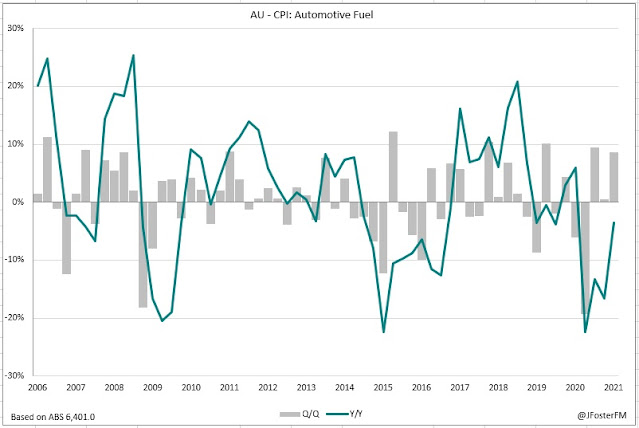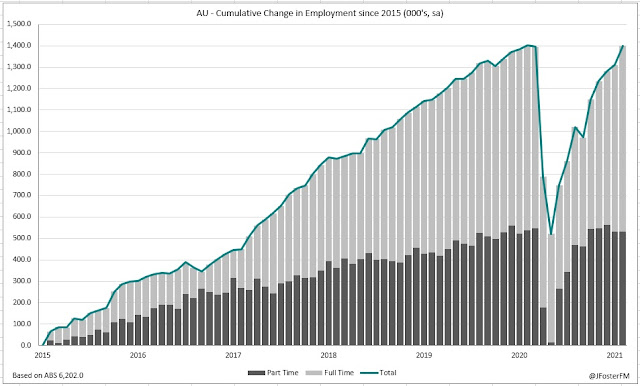Friday, April 30, 2021
Macro (Re)view (30/4) | Staying patient through the recovery
Tuesday, April 27, 2021
Australian Q1 CPI 0.6%, 1.1%yr
Australia's Consumer Price Index (CPI) came in weaker than expected across all key readings in the March quarter. Policy-related effects are creating a lot of volatility within the data, but there is little to indicate that a strong economic rebound is leading to broad-based underlying inflationary pressures.
Consumer Price Index — Q1 | By the numbers
- Headline CPI (not seasonally adjusted) was softer than expected at 0.6% in Q1 against the median estimate of 0.9% and was down from 0.9% in Q4. Annual CPI firmed to 1.1% from 0.9% but was below the 1.4% rate expected. Seasonally adjusted CPI softened to 0.5% in Q1 (from 0.9% in Q4), leaving the annual pace little changed at around 1%.
- Details for the underlying measures (measures are seasonally adjusted);
- Trimmed mean lifted 0.35%q/q, coming in well below the 0.6% pace expected, while the annual pace eased to 1.09% from 1.17%.
- Weighted median increased by 0.42%q/q as the pace through the year held around 1.3%.
Preview: Australian CPI Q1
Friday, April 23, 2021
Macro (Re)view (23/4) | Prospects for less accommodative policy in focus
Friday, April 16, 2021
Macro (Re)view (16/4) | Strength to strength in Australia's recovery
Wednesday, April 14, 2021
Australian employment 70.7k in March; unemployment rate 5.6%
The Australian labour market approached the withdrawal of the JobKeeper wage subsidy and other income support measures full of running with employment rising by a much stronger-than-expected 70.7k in March following on from the 88.7k surge in the month prior. The national unemployment rate has declined to a pandemic low of 5.6% after hitting a peak of 7.5% during the worst of the crisis.
Labour Force Survey — March | By the numbers
- Employment (on net) increased by 70.7k in March, topping the range of estimates for the second consecutive month and was double the 35.0k rise expected. February's outcome was unrevised by the ABS at 88.7k.
- National unemployment declined from 5.8% to 5.6%, outperforming expectations for a smaller fall to 5.7%.
- Australia's participation rate rose to a record high at 66.3%, up from 66.1% in February, which comes 10 months the nadir where the shutdown had crunched the rate to a 21-year low.
- Hours worked advanced by 2.2% in the month to 1.8bn hours adding to the 5.8% rebound in February (revised from 6.1%). Total hours worked have now risen back above their pre-pandemic level.
Preview: Labour Force Survey — March
Australia's latest report on labour market conditions for the month of March is due to be published by the ABS at 11:30am (AEST) this morning. Nine months after the reopening of the national economy, employment completed a v-shaped recovery to its pre-pandemic level after a much stronger-than-expected rise of 88.7k in February. Headline unemployment fell to its lowest level in the period, declining from 6.3% to 5.8% but remained well above its pre-pandemic rate of 5.2%. Today's report comes ahead of the withdrawal of the Federal Government's JobKeeper wage subsidy policy that maintained employer-employee connections and supported incomes through the earlier shutdowns.
As it stands | Labour Force SurveyThe median estimate is for employment to rise by 35.0k in March, with forecasts ranging up to 65.0k on the high side and 10.0k on the low side. National unemployment is anticipated to tick lower to 5.7% from 5.8%; the range of estimates is between 5.6% and 5.9%.
What to watch | Labour Force Survey









































